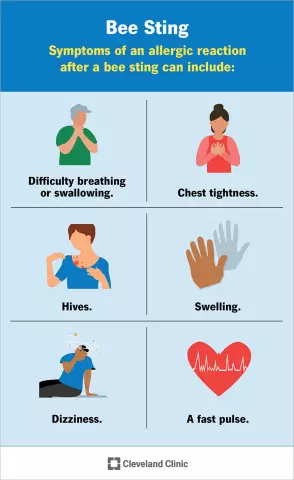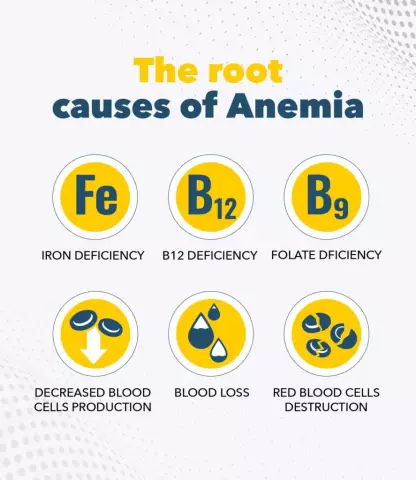Diseases
Last modified: 2025-11-02 20:11
Alopecia is a disease that leads to complete baldness of a person. It appears due to an abnormally high content of the hormone testorone
Last modified: 2025-11-02 20:11
Allergic cough in an adult is a common pathology that requires increased attention, as it can turn into a number of diseases of allergic etiology
Last modified: 2025-11-02 20:11
Allergic dermatitis is an inflammation of the skin caused by its contact with an allergen. Symptoms of the disease are skin redness, itching, the appearance of small bubbles on it
Last modified: 2025-11-02 20:11
Albinism is a disease that occurs due to a lack of the enzyme tyrosinase and is characterized by a lack of melanin pigment
Last modified: 2025-11-02 20:11
Cold allergy manifests itself clinically in different ways. Symptoms can include urticaria, conjunctivitis, rhinitis, and even bronchial asthma
Last modified: 2025-11-02 20:11
Amblyopia or "lazy eye" is a fairly common ophthalmic disease. The traditional treatment for amblyopia is occlusion. It is also possible to correct vision using video-computer auto-training
Last modified: 2025-11-02 20:11
Alveococcosis (multi-chamber or alveolar echinococcosis) is a parasitic disease that is caused by the larvae of the helminth Alveococcus multilocularis. Once in the liver, it forms a tumor-like formation with infiltrative growth, as well as the ability to metastasize to the brain, lungs and some other organs
Last modified: 2025-11-02 20:11
Leber's amaurosis is a genetic ophthalmic disease that leads to a significant deterioration in visual function (up to its complete loss). It is based on irreversible damage to light-sensitive cells of the retina of the eyeball (cones and rods)
Last modified: 2025-11-02 20:11
Ameloblastoma is a benign tumor of the maxillofacial region, accompanied by the destruction of bone tissue. This is one of the most common tumors in dental surgery. In more than 80% of cases, ameloblastoma is localized in the lower jaw
Last modified: 2025-11-02 20:11
Amenorrhea, translated from Latin, means the absence of monthly bleeding, that is, menstruation. Treatment of amenorrhea consists in eliminating the cause that caused its appearance
Last modified: 2025-11-02 20:11
Ametropia is a violation of the refraction of the eyeball, in which the refracted light rays are focused not on the retina (as it should be normal), but behind or in front of it. As a result, a person sees the world around him fuzzy and blurry. This is a common ophthalmic pathology
Last modified: 2025-11-02 20:11
Amnesia is a disease characterized by partial or complete memory loss for a short or long period
Last modified: 2025-11-02 20:11
Amok is a state of acute mental insanity, in which a patient, armed with a cold weapon or firearms, kills the first people he comes across without realizing it. This episode of violent insanity often ends in suicide
Last modified: 2025-11-02 20:11
An anal fissure is a violation of the integrity of the anal mucosa. Anal fissures are usually divided into acute and chronic
Last modified: 2025-11-02 20:11
Amyloidosis is a systemic disease in which amyloid (protein-polysaccharide substance (glycoprotein)) is deposited in organs and tissues, which leads to disruption of their functions
Last modified: 2025-11-02 20:11
Anaphylaxis - the body's reaction to a specific allergen, accompanied by muscle spasms, edema, severe pain and suffocation
Last modified: 2025-11-02 20:11
Alveolitis is a lung disease in which the inflammatory process is localized in the terminal airways (bronchioles, alveoli)
Last modified: 2025-11-02 20:11
Amoebiasis is a disease caused by a histolytic amoeba that occurs with extraintestinal and intestinal symptoms
Last modified: 2025-11-02 20:11
Anankastic personality disorder is a mental disorder characterized by hypertrophied insecurity in one's actions and their consequences, pathological scrupulousness, excessive concentration on details, intransigence, pathological perfectionism, recurrent obsessive thoughts, ideas, actions, or a combination of these
Last modified: 2025-11-02 20:11
Anaplasmosis is an acute transmissible infectious disease with a polymorphic clinic, the causative agent of which, anaplasma (Anaplasma phagocytophillum), is transmitted by ixodid ticks
Last modified: 2025-11-02 20:11
Anaphylactic shock is an acute allergic process that develops in a sensitized body in response to repeated contact with an allergen and is accompanied by hemodynamic disturbances, leading to circulatory failure and, as a result, acute oxygen starvation of vital organs
Last modified: 2025-11-02 20:11
Angina Simanovsky-Plaut-Vincent - an infectious disease that affects the adenoid and lymphatic apparatus of the pharyngeal tonsils
Last modified: 2025-11-02 20:11
Angiodystonia affects arterial and venous vessels. It is not an independent disease, but is included in the complex of symptoms of the underlying disease. Angiodystonia is a violation of vascular tone caused by a violation of the structure of the walls of blood vessels, as well as the development of the muscle layer, which is excessively or insufficiently functioning and manifests itself as a local or general disturbance of blood flow
Last modified: 2025-11-02 20:11
Anhidrosis is a pathological condition caused by a dysfunction of the sweat glands and manifested by a sharp decrease in sweating until it stops completely
Last modified: 2025-11-02 20:11
Angioma is a benign mass of lymphatic and blood vessels
Last modified: 2025-11-02 20:11
Angiomyolipoma - a benign tumor that forms in the kidney and pancreas
Last modified: 2025-11-02 20:11
Anhydrotic ectodermal dysplasia is a hereditary disease caused by a genetic defect and characterized by congenital anomalies in the development of teeth, sweat and sebaceous glands, hair follicles and glands of the mucous membranes
Last modified: 2025-11-02 20:11
Angiokeratoma - dermatosis, represented by single or multiple benign vascular neoplasms such as angiomas, combined with pathological thickening of the stratum corneum
Last modified: 2025-11-02 20:11
Angioedema (Quincke's edema) is an acute condition characterized by the rapid development of local edema of the mucous membrane, subcutaneous tissue and the skin itself. More often occurs on the face (tongue, cheeks, eyelids, lips) and much less often affects the mucous membranes of the genitourinary organs, gastrointestinal tract, respiratory tract
Last modified: 2025-11-02 20:11
Angiopathy is damage to blood vessels caused by a disorder of nervous regulation. In the treatment of angiopathy, drugs are used as prescribed by a doctor
Last modified: 2025-11-02 20:11
Aneurysm is a bulging of the wall of an artery due to its thinning or stretching. In modern medicine, there is only one way to treat aneurysm - this is surgery (operation)
Last modified: 2025-11-02 20:11
Angiosarcoma (hemangioendothelioma) is a rare malignant tumor originating from the endothelium (cells of the inner surface) of blood or lymph vessels. Differs in resistance to therapy and rapid metastasis
Last modified: 2025-11-02 20:11
Angina is a common infectious disease in which the lymphoid tissue of the pharynx, mainly the palatine tonsils, is exposed to acute inflammation
Last modified: 2025-11-02 20:11
Anemia is a low concentration of hemoglobin in human blood associated with a deficiency of iron in the body. Specialists identify three main degrees of anemia, which are divided into mild, moderate and severe
Last modified: 2025-11-02 20:11
Angiopathy is a pathological process in which there is damage to the blood vessels. There can be many reasons for angiopathy, the most common being diabetes
Last modified: 2025-11-02 20:11
Aortic aneurysm - an expansion of a limited area of the aortic wall, resembling a spindle or a sac-shaped formation, or a diffuse increase in its lumen by more than 2 times compared with an unchanged area (or a normal diameter of the aorta for a given sex and age)
Last modified: 2025-11-02 20:11
Fanconi's anemia is a rare disease, the development of which is caused by a genetic defect in a group of proteins responsible for the repair (correction of breaks and errors) of DNA molecules. This leads to increased fragility of chromosomes, as a result of which aplastic anemia develops in patients with age and neoplastic processes are triggered
Last modified: 2025-11-02 20:11
Aneurysm of cerebral vessels (intracranial aneurysm, cerebral aneurysm) is a protrusion of the arterial wall due to a violation of its normal three-layer structure. Aneurysm of cerebral vessels is localized mainly in the places of arterial branching
Last modified: 2025-11-02 20:11
An abdominal aortic aneurysm is an expansion or bulging of the wall of the abdominal aorta. The disease is often asymptomatic
Last modified: 2025-11-02 20:11
Anisometropia is a violation of visual function, in which the refractive error index (a defect in the refraction of light rays) is different for each eyeball. For a full-fledged vision correction in this case, it is necessary to use lenses not of the same, but of different optical power








































